For a recent cooking class, my tutee wanted to make rum cake. I don’t have rum cake in my repertoire, and although there are several fortified Nicaraguan desserts and rum is like mother’s milk to the populace, I couldn’t find one in the infamous Nica Joy of Cooking, Doña Angélica. My mom suggested I use our household orange bundt as a base and replace some of the milk with rum. A sensible suggestion, but I Googled “rum cake” anyway. Boxed yellow cake + rum. Not quite the avenue I’d planned on taking.
But then, an actual recipe claiming to be some well-known rum company’s original TOP SECRET recipe…
I like secrets! And I also like that this recipe had 3 sticks of butter plus 1 cup of heavy cream.
I added a few spices to the recipe and, deciding that ¾ cup rum in the cake was stingy (mother’s milk, remember?), made a buttery-burnt sugar-orange-rum glaze. This cake is incredibly moist and stays that way for about a week. Love it. Love it. Love it.
RUM CAKE with BUTTERED RUM GLAZE
I recommend a 7 or 12-year-old Flor de Caña (Nicaraguan rum) for this cake. If you can’t get Flor, substitute with dark rum of your liking. For an extra burst of orange flavor, process the sugar and orange zest in a food processor for about 1 minute.
Prepare the glaze while the cake is in the oven. It’s best to use a stainless steel saucepan for this recipe—a dark pan will make it difficult to determine the caramel’s color and progress. Avoid a shallow pan as there will be sputtering.
¡Atención! The base of this glaze is caramel, just like the one on flan. Please be careful when working with hot sugar—it’s like liquid napalm and you should never be tempted to stick your finger in the pot to have a taste. Unless you’re looking to erase the friction ridges on your fingertips.
For the Cake
3 cups all-purpose flour
2 teaspoons baking powder
½ teaspoon baking soda
½ teaspoon ground cinnamon
½ teaspoon ground ginger
¼ teaspoon ground allspice
¼ teaspoon salt
1 cup heavy cream
¾ cup dark rum
1½ cups (3 sticks) unsalted butter, softened
1½ cups sugar
1 tablespoon grated orange zest
1 teaspoon vanilla extract
3 large eggs plus 1 large egg yolk
– Position a rack in the middle of the oven and preheat it to 350˚F. Butter and flour (or spray with Pam for Baking) a Bundt pan.
– Sift together the flour, baking powder, baking soda, cinnamon, ginger, allspice, and salt; set aside. Combine the cream and rum in a liquid measuring cup; set aside.
– With an electric mixer (use the paddle attachment if using standing mixer) on medium speed, beat the butter, sugar, and zest until light and fluffy, about 3 minutes. Add the egg yolk and beat until fully incorporated. Add the whole eggs, one at a time, beating well after each addition. Add the vanilla and reduce speed to low. Add the flour mixture in 3 additions, alternating with the cream-rum mixture, stopping once or twice to scrape the sides and bottom of bowl with a rubber spatula. Mix until smooth, about 1 minute.
– Pour the batter into the prepared Bundt pan and bake until a toothpick inserted into the cake comes out clean, about 1 hour.
For the Buttered Rum Glaze
½ cup dark rum
½ cup orange juice (use the zested orange from the cake recipe)
1 cup sugar
¼ cup water
2 tablespoons unsalted butter
¼ teaspoon salt
– Combine the rum and orange juice in a liquid measuring cup; set aside.
– Place the sugar and water in a heavy bottomed, stainless steel, medium saucepan. Bring the mixture to a boil over medium-high heat and cook, gently swirling the saucepan from time to time, until the sugar turns deep amber and begins to smoke, 10 to 12 minutes.
– Immediately remove the saucepan from heat, and slowly and carefully pour in the rum-orange juice mixture. The mixture will sputter quite violently—don’t move the saucepan or stir the mixture. Once the sputtering has subsided, return the saucepan to medium heat, and with a heat-proof rubber spatula, stir until smooth, about 3 minutes. Stir in the butter and salt. Reserve ½ cup of the glaze.
– Once the cake is out of the oven, poke it all over with a metal or wooden skewer. Pour the remaining glaze over the cake and allow it to sit in the pan for 20 minutes before turning out onto a cooling rack. Brush the cake with the reserved glaze and cool completely before serving.


